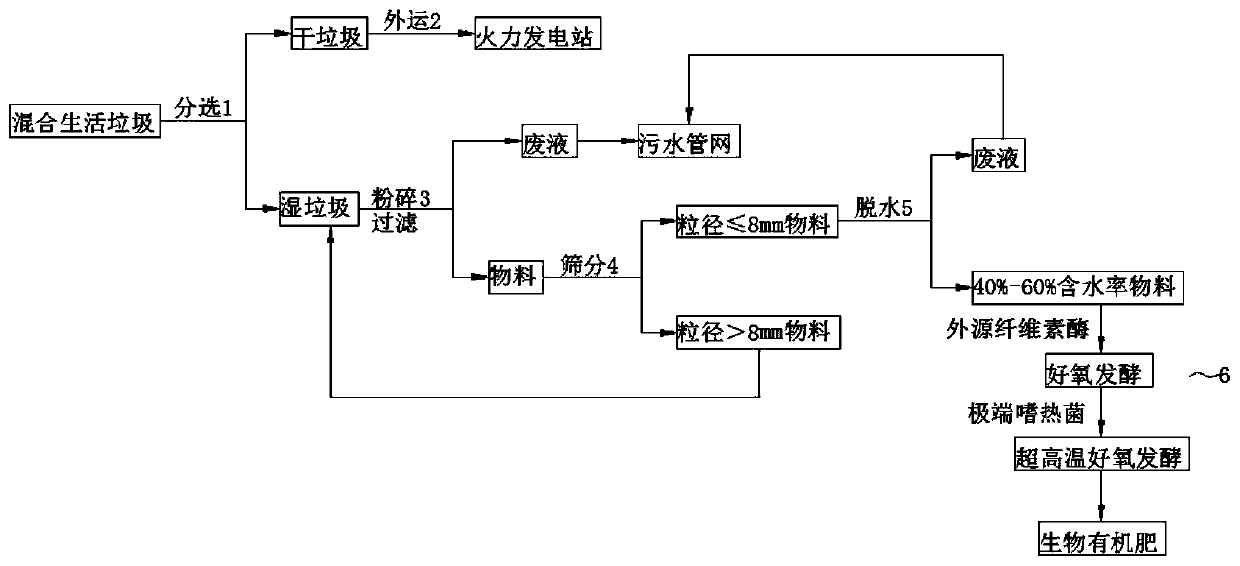Household garbage dry and wet separation resourceful treatment method
A technology for separating dry and wet waste from domestic waste, applied in chemical instruments and methods, climate change adaptation, organic fertilizers, etc., can solve problems such as long fermentation cycle, breeding of mosquitoes and flies, and odor pollution, so as to shorten the composting time and reduce Energy consumption, the effect of accelerating the composting process
- Summary
- Abstract
- Description
- Claims
- Application Information
AI Technical Summary
Problems solved by technology
Method used
Image
Examples
Embodiment 1
[0045] A method for resource recycling of domestic waste by dry-wet separation, comprising the following steps:
[0046] Mixed domestic waste sorting 1: The mixed domestic waste is divided into dry and wet waste through the sorting table, and enters the unused waste compartments respectively. Wet garbage: perishable garbage, mainly including food waste, leftovers, expired food, melon skin and fruit stones, flowers and green plants, traditional Chinese medicine residues and other perishable biomass domestic waste; dry garbage: other garbage, Including household waste other than recyclables (paper, plastic, glass, metal, fabric, etc.), hazardous waste (batteries, light tubes, medicines, paint, etc.), wet waste;
[0047] Dry waste transport treatment 2: transport the collected dry waste to the thermal power station for incineration and power generation;
[0048] Wet garbage crushing and filtering 3: Put the collected wet garbage into the garbage shredder, through crushing and fi...
Embodiment 2
[0055] A method for resource recycling of domestic waste by dry-wet separation, comprising the following steps:
[0056] Mixed domestic waste sorting 1: The mixed domestic waste is divided into dry and wet waste through the sorting table, and enters the unused waste compartments respectively. Wet garbage: perishable garbage, mainly including food waste, leftovers, expired food, melon skin and fruit stones, flowers and green plants, traditional Chinese medicine residues and other perishable biomass domestic waste; dry garbage: other garbage, Including household waste other than recyclables (paper, plastic, glass, metal, fabric, etc.), hazardous waste (batteries, light tubes, medicines, paint, etc.), wet waste;
[0057] Dry waste transport treatment 2: transport the collected dry waste to the thermal power station for incineration and power generation;
[0058] Wet garbage crushing and filtering 3: Put the collected wet garbage into the garbage shredder, through crushing and fi...
Embodiment 3
[0065] A method for resource recycling of domestic waste by dry-wet separation, comprising the following steps:
[0066] Mixed domestic waste sorting 1: The mixed domestic waste is divided into dry and wet waste through the sorting table, and enters the unused waste compartments respectively. Wet garbage: perishable garbage, mainly including food waste, leftovers, expired food, melon skin and fruit stones, flowers and green plants, traditional Chinese medicine residues and other perishable biomass domestic waste; dry garbage: other garbage, Including household waste other than recyclables (paper, plastic, glass, metal, fabric, etc.), hazardous waste (batteries, light tubes, medicines, paint, etc.), wet waste;
[0067] Dry waste transport treatment 2: transport the collected dry waste to the thermal power station for incineration and power generation;
[0068] Wet garbage crushing and filtering 3: Put the collected wet garbage into the garbage shredder, through crushing and fi...
PUM
 Login to View More
Login to View More Abstract
Description
Claims
Application Information
 Login to View More
Login to View More - R&D
- Intellectual Property
- Life Sciences
- Materials
- Tech Scout
- Unparalleled Data Quality
- Higher Quality Content
- 60% Fewer Hallucinations
Browse by: Latest US Patents, China's latest patents, Technical Efficacy Thesaurus, Application Domain, Technology Topic, Popular Technical Reports.
© 2025 PatSnap. All rights reserved.Legal|Privacy policy|Modern Slavery Act Transparency Statement|Sitemap|About US| Contact US: help@patsnap.com

